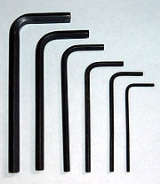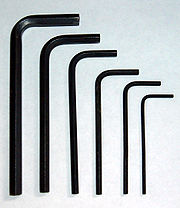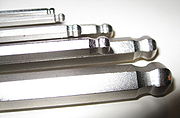
Hex key
Encyclopedia


Tool
A tool is a device that can be used to produce an item or achieve a task, but that is not consumed in the process. Informally the word is also used to describe a procedure or process with a specific purpose. Tools that are used in particular fields or activities may have different designations such...
of hexagonal cross-section used to drive bolts and screw
Screw
A screw, or bolt, is a type of fastener characterized by a helical ridge, known as an external thread or just thread, wrapped around a cylinder. Some screw threads are designed to mate with a complementary thread, known as an internal thread, often in the form of a nut or an object that has the...
s that have a hexagonal socket in the head (internal-wrenching hexagon drive).
Nomenclature
The term "hex key" has various synonyms. Some are explained by the geographical and commercial history of the drive type's development; these include Allen, Unbrako, and Inbus key or wrench. The synonym zeta key or wrench refers to the sixth letter of the Greek alphabetZeta
-Science:* Zeta functions, in mathematics** Riemann zeta function* Zeta potential, the electrokinetic potential of a colloidal system* Tropical Storm Zeta , formed in December 2005 and lasting through January 2006* Z-pinch, in fusion power...
. The term hex-head is sometimes used to refer to this type of drive, but this use is not consistent with its more conventional use referring to external-wrenching hexagons.
In the fastener industry, the terms socket head or hex socket head are generally used for the driven part of the driver–driven pair. A less common synonym is female
Gender of connectors and fasteners
In electrical and mechanical trades and manufacturing, each half of a pair of mating connectors or fasteners is conventionally assigned the designation male or female...
hex.
Features
Some features of hex keys are:- The tool is simple, small and light.
- The contact surfaces of the screw or bolt are protected from external damage.
- There are six contact surfaces between bolt and driver.
- The tool can be used with a headless screw.
- The screw can be inserted into its hole using the key.
- TorqueTorqueTorque, moment or moment of force , is the tendency of a force to rotate an object about an axis, fulcrum, or pivot. Just as a force is a push or a pull, a torque can be thought of as a twist....
is constrained by the length and thickness of the key. - Very small bolt heads can be accommodated.
- The tool can be manufactured very cheaply, so one is often included with products requiring end-user assembly.
- Either end of the tool can be used to take advantage of reach or torque.
History
Extant records suggest (without offering exhaustive documentation) that the idea of a hex socket screw drive was probably conceived as early as the 1860s through 1890s, but that such screws were probably not manufactured until around 1911. Rybczynski (2000) describes a flurry of patents for alternative drive types in the 1860s through 1890s in the US, which are confirmed to include internal-wrenching square and triangle types (that is, square and triangular sockets) , but he explains that these were patented but not manufactured due to the difficulties and expense of doing so at the time. P. L. RobertsonP. L. Robertson
Peter Lymburner Robertson was a Canadian inventor, industrialist, salesman, and philanthropist who popularized the square-socket drive for screws...
, of Milton, Ontario, Canada, first commercialized the square socket in 1908, having perfected a manufacturing method. The first manufacture of an internal-wrenching hexagon drive of which records have surfaced is that of circa 1911 by the Standard Pressed Steel Company (SPS), then of Philadelphia, later of Jenkintown, Pennsylvania
Jenkintown, Pennsylvania
Jenkintown is a borough in Montgomery County, Pennsylvania, about 10 miles north of downtown Philadelphia. "Jenkintown" is also used to describe a number of neighborhoods surrounding the borough, which also are known by names such as Rydal, Jenkintown Manor and Noble...
. (This company was the predecessor corporation to today's SPS Technologies, Inc.) SPS had sourced set screw
Set screw
A set screw is a type of screw generally used to secure an object within or against another object. The most common examples are securing a pulley or gear to a shaft. Set screws are most often headless , meaning that the screw is fully threaded and has no head projecting past the major diameter of...
s of square-socket drive from England, but they were very expensive. (This was only 2 years after Robertson's Canadian patent.) This cost problem drove SPS to purchase its first screw machine
Screw machine
A screw machine may refer to a:* Screw machine , a small- to medium-sized automatic lathe that is mechanically automated via cams...
and make its screws in-house, which soon led to SPS's foray into fastener sales (for which it later became well known within the metalworking industries). H. T. Hallowell, Sr., founder of SPS, in his memoir (1951) says that "[for] a while we experimented with a screw containing a square hole like the English screw but soon found these would not be acceptable in this country [the U.S.]. Then we decided to incorporate a hexagon socket into the screw […]." Hallowell does not elaborate on why SPS found that the square hole "would not be acceptable in this country", but it seems likely that it would have to have involved licensing Robertson's patent, which would have defeated SPS's purpose of driving down its cost for internal-wrenching screws (and may have been unavailable at any price, as explained at "List of screw drives > Robertson").
Soon after SPS had begun producing the [hex] socket head set screw, Hallowell had the idea to make a [hex] socket head cap screw (SHCS). Hallowell said, "Up to this moment none of us had ever seen a socket head cap screw, and what I am about to relate concerns what I believe was the first socket head cap screw ever made in this country [the U.S.]." SPS gave their line of screws the brand name, chosen for its echoing of the word unbreakable.
Hallowell said that acceptance of the internal-wrenching hexagon drive was slow at first (painfully slow for SPS's sales), but that it eventually caught on quite strongly. This adoption occurred first in tool and die work
Tool and die maker
Tool and die makers are workers in the manufacturing industry who make jigs, fixtures, dies, molds, machine tools, cutting tools , gauges, and other tools used in manufacturing processes...
and later in other manufacturing fields such as defense (aircraft, tanks, submarines), civilian aircraft, automobiles, bicycles, furniture, and others.
Concerning the dissemination of the screws and wrenches, Hallowell said that "the transition from a square head set screw [Hallowell refers here to the then-ubiquitous external-wrenching square drive] to a hexagon socket head hollow set screw[,] for which had to be developed special keys or wrenches for tightening or loosening the screw, was the cause of more profanity among the mechanics and machine manufacturers than any other single event that happened. […] I am sure that the old-timers who read this book will remember this period vividly." (These transitional growing pains echo those experienced many decades later with the adoption of the Torx
Torx
Torx developed by Camcar Textron, is the trademark for a type of screw head characterized by a 6-point star-shaped pattern. People who are unfamiliar with the trademark generally use the term star, as in star screwdriver or star bits...
drive).
World War II, with its unprecedented push for industrial production of every kind, is probably the event that first put most laypersons in contact with the internal-wrenching hexagon drive. (Popular Science magazine would note in 1946 that "Cap screws and setscrews with heads recessed to take hexagonal-bar wrenches are coming into increasing use.") As Hallowell explained, the dissemination of the wrenches somewhat lagged behind the adoption of the fasteners. The shortfall in distribution against a background of gigantic wartime demand might have created a partial vacuum in the market.
The wrench trademark of the Allen Manufacturing Company of Hartford, Connecticut
Hartford, Connecticut
Hartford is the capital of the U.S. state of Connecticut. The seat of Hartford County until Connecticut disbanded county government in 1960, it is the second most populous city on New England's largest river, the Connecticut River. As of the 2010 Census, Hartford's population was 124,775, making...
was taken out in 1943, and Allen became such a successful brand of hex key that many consumers in subsequent decades have assumed (reasonably but incorrectly) that the internal-wrenching hexagon drive was invented by someone named Allen.
It appears that the internal-wrenching hexagon drive may have been independently reinvented in various countries. At the least, it was patented in various countries by various patentees, and its name varies. For example, in various European countries, it is known by the name (often misspelled *Imbus), after the company that patented them in Germany in 1936, Bauer und Schaurte of Neuss
Neuss
Neuss is a city in North Rhine-Westphalia, Germany. It is located on the west bank of the Rhine opposite Düsseldorf. Neuss is the largest city within the Rhein-Kreis Neuss district and owes its prosperity to its location at the crossing of historic and modern trade routes. It is primarily known...
(Inbus stands for Innensechskantschraube Bauer und Schaurte). Similarly, there is another name in Italian (brugola), stemming from an Italian company's name.
Hex key standard sizes
Hex keys are measured across-flats (AF), which is the distance between two opposite (parallel) flat sides of the key. Standard metric sizes are defined in ISOInternational Organization for Standardization
The International Organization for Standardization , widely known as ISO, is an international standard-setting body composed of representatives from various national standards organizations. Founded on February 23, 1947, the organization promulgates worldwide proprietary, industrial and commercial...
2936:2001 "Assembly tools for screws and nuts—Hexagon socket screw keys", also known as DIN
Deutsches Institut für Normung
is the German national organization for standardization and is that country's ISO member body. DIN is a Registered German Association headquartered in Berlin...
911, and, measured in millimeters (mm) are:
- 0.7, 0.9, 1.0, 1.25, 1.3, 1.5
- 2 to 6 in 0.5 mm increments
- 7 to 22 in 1 mm increments
- 24, 25, 27, 30, 32, 36, 42 and 46 mm.
Metric hex wrench sizes are sometimes referred to using the designation "M" followed by the size in millimeters of the tool or socket, e.g. "M6", although this may be confused with the standard use of "M6" which refers to the threads of a metric screw or bolt.
American sizes are defined in ANSI
American National Standards Institute
The American National Standards Institute is a private non-profit organization that oversees the development of voluntary consensus standards for products, services, processes, systems, and personnel in the United States. The organization also coordinates U.S. standards with international...
/ASME
American Society of Mechanical Engineers
The American Society of Mechanical Engineers is a professional body, specifically an engineering society, focused on mechanical engineering....
standard B18.3-1998 "Socket Cap, Shoulder, and Set Screws (Inch Series)". Values given here are taken from Machinery's Handbook, 26th Edition, section "Fasteners", chapter "Cap and Set Screws", table 4 (p. 1601).
| Screw size (nominal) | Socket size (inches) | Approximate socket size (mm) |
|---|---|---|
| No. 6 | 7/64 | 2.78 |
| No. 8 | 9/64 | 3.57 |
| No. 10 | 5/32 | 3.97 |
| 1/4 | 3/16 | 4.76 |
| 5/16 | 1/4 | 6.35 |
| 3/8 | 5/16 | 7.94 |
| 7/16 | 3/8 | 9.52 |
| 1/2 | 3/8 | 9.52 |
| 5/8 | 1/2 | 12.7 |
| 3/4 | 5/8 | 15.9 |
| 7/8 | 3/4 | 19.0 |
| 1 | 3/4 | 19.0 |
Note that numerous other sizes are defined; these are the most common.
Using a hex wrench on a socket that is too large may result in damage to the fastener or the tool. An example would be using a 5 mm tool in a 5.5 mm socket. Because hex-style hardware and tools are available in both metric
Metric system
The metric system is an international decimalised system of measurement. France was first to adopt a metric system, in 1799, and a metric system is now the official system of measurement, used in almost every country in the world...
and British/Imperial
Imperial unit
The system of imperial units or the imperial system is the system of units first defined in the British Weights and Measures Act of 1824, which was later refined and reduced. The system came into official use across the British Empire...
sizes (with British sizes most commonly used in the United States and denoted "SAE", and metric in other places), it is also possible to select a tool that is too small for the fastener by using a British-unit/Imperial tool on a metric fastener, or the converse. There are some exceptions to that. For example, 4 mm keys are almost exactly the same size as 5/32", and 8 mm keys are almost exactly the same size as 5/16", which makes 4 mm and 8 mm preferred number
Preferred number
In industrial design, preferred numbers are standard guidelines for choosing exact product dimensions within a given set of constraints....
s for consumer products such as self-assembly particle-board furniture, because end users can successfully use an imperial key on a metric fastener, or vice versa, without stripping. 19 mm keys are so close to the same size as 3/4" that they are completely interchangeable in practical use.
Variants

Torx
Torx developed by Camcar Textron, is the trademark for a type of screw head characterized by a 6-point star-shaped pattern. People who are unfamiliar with the trademark generally use the term star, as in star screwdriver or star bits...
head's security variant also has such a pin for the same reason.
Some hex keys have a ball on one end, which allows the tool to be used at an angle off-axis to the screw. This type of hex key was invented in 1964 by the Bondhus Corporation, and is now manufactured by several other companies.
While providing access to otherwise inaccessible fasteners, thinning of the tool shaft to create the ball shape renders it weaker than the straight-shaft version, limiting the torque that can be applied. The tool also makes point contact with the fastener as opposed to the line contact seen in the straight style tools.
Manufacturing methods
- Hex socket screw heads are usually made by stamping the head with a dieDie (manufacturing)A die is a specialized tool used in manufacturing industries to cut or shape material using a press. Like molds, dies are generally customized to the item they are used to create...
, plasticly deforming the metal. Other ways to generate the hex socket include linear broaching and rotary broaching. Broaching the heads with a linear broach is essentially the metalworking analog of mortising wood with a mortising machine; a hole is drilled and then the corners are broached out. This operation often leaves little telltale curled chips still attached at the bottom of the socket. These are negligible for most applications. - Hex keys are made by imparting the hexagon cross-section to steel wire (for example, with a die), then bending and shearing.

